Sold Ceramics
Sold Shipwreck Porcelains
The Ca Mau Shipwreck c.1725
Page 1
The Ca Mau Shipwreck, c.1725
The Ca Mau shipwreck was a Chinese ocean going junk, almost certainly en route from Canton (now Kuangzhou) to the Dutch trading port of Batavia (now Jakarta). Disaster struck of the Ca Mau peninsular, there was a fire on board so severe that some of the porcelain was fused together. There were a few wine cups recovered bearing the mark of the Emperor Yongzheng who reigned from 1723 to 1735. By this time tea and coffee was the rage throughout Europe and the principal traders were the British 'Honourable East India Company' and the Dutch East India Company, (Vereenigde Oost-Indische Compagnie, VOC). With the demand for tea came demand for porcelain by which to drink it and so most of what they imported in these year was tea wares.(Amsterdam 2007, pp.8-9)
The Ca Mau shipwreck was discovered by fishermen working of the Ca Mau peninsular when their nets snagged on it. When they realised the porcelain was saleable they began dredging up as much as possible. Once the Vietnamese Ministry of Culture and Information realised what was happening they moved in quickly to secure the wreck site. The excavation was lead by the Curator of The National Museum of Vietnamese culture. Most pieces not only have the Sotheby’s auction label but also the 'CM' reference number of the Vietnamese conservators. In all, 130,000 pieces were recovered and 76,000 of the finer condition pieces were selected to be sold as 'Made in Imperial China. 76,000 pieces of Chinese Export Porcelain from the Ca Mau Shipwreck, circa 1725' by Sotheby’s Amsterdam on 29, 30 & 31 January 2007. (Amsterdam 2007, pp.6-7)
The Ca Mau wreck was first reported on in the daily newspaper Tuoi Tre (Youth) on May 5th1998. Accordingly, the authority of Binh Thuan province had confiscated 32,569 artefacts and 2,4 tons of metal objects recovered illegally by two fishermen from a shipwreck off the coast of Ca Mau province. Two experts dated 33,978 artefacts, mainly ceramics, to the Yongzheng reign of the Qing dynasty (1723-1735). Afterward, the recoveries, coded CM1, were handed over to the Binh Thuan Museum. (Amsterdam 2007, p.11)

Sold Ceramics - Sold Shipwreck Porcelains - The Ca Mau Shipwreck, c.1725 - Page 1
Object 2011866
Dish
China
c.1725
Provenance: Made in Imperial China 76.000 pieces of Chinese export porcelain from the Ca Mau shipwreck, circa. 1725, Sotheby's Amsterdam, 29,30 & 31 January 2007; Jan-Erik Nilsson Collection.
Height 23 mm (0.91 inch), diameter of rim 221 mm (8.70 inch), diameter of footring 121 mm (4.76 inch), weight 326 grams (11.50 ounce (oz.))
Dish on footring with moulded sides and a scalloped rim. Decorated in underglaze blue with a village with a church and houses, a lighthouse with trees, figures with a cow and poles with clouds. On the reverse stylized foliate scrolls. The low footring is encircled with a double concentric band. Marked on the base with a square fuku mark (good luck) in seal script. On the base a circular plastic collector label that reads: 'Jan-Erik Nilsson Collection YZ 11'.
The Ca Mau shipwreck was a Chinese ocean going junk, almost certainly en route from Canton (now Kuangzhou) to the Dutch trading port of Batavia (now Jakarta). Disaster struck of the Ca Mau peninsular, there was a fire on board so severe that some of the porcelain was fused together. There were a few wine cups recovered bearing the mark of the Emperor Yongzheng who reigned from 1723 to 1735. By this time tea and coffee was the rage throughout Europe and the principal traders were the British 'Honourable East India Company' and the Dutch East India Company, (Verenigde Oost-Indische Compagnie, VOC). With the demand for tea came demand for porcelain by which to drink it and so most of what they imported in these year was tea wares.(Amsterdam 2007, pp.8-9)
The Ca Mau shipwreck was discovered by fishermen working of the Ca Mau peninsular when their nets snagged on it. When they realised the porcelain was saleable they began dredging up as much as possible. Once the Vietnamese Ministry of Culture and Information realised what was happening they moved in quickly to secure the wreck site. The excavation was lead by the Curator of The National Museum of Vietnamese culture. Most pieces not only have the Sotheby’s auction label but also the 'CM' reference number of the Vietnamese conservators. In all, 130,000 pieces were recovered and 76,000 of the finer condition pieces were selected to be sold as 'Made in Imperial China. 76,000 pieces of Chinese Export Porcelain from the Ca Mau Shipwreck, circa 1725' by Sotheby’s Amsterdam on 29, 30 & 31 January 2007. (Amsterdam 2007, pp.6-7)
The Ca Mau wreck was first reported on in the daily newspaper Tuoi Tre (Youth) on May 5th1998. Accordingly, the authority of Binh Thuan province had confiscated 32,569 artefacts and 2,4 tons of metal objects recovered illegally by two fishermen from a shipwreck off the coast of Ca Mau province. Two experts dated 33,978 artefacts, mainly ceramics, to the Yongzheng reign of the Qing dynasty (1723-1735). Afterward, the recoveries, coded CM1, were handed over to the Binh Thuan Museum. (Amsterdam 2007, p.11)
In the cargo of the Ca Mau shipwreck, c.1725 (Amsterdam 2007, p.179) a total of 80 dishes decorated with the Chine de commande 'Deashima Island or Scheveningen decoration' were found. As we know the original designs were traditionally made in Japan for the Dutch. These dishes were so popular that Chinese potters copied them in order to compete with the Japanese. Such copies were already known, but the occurrence in the Ca Mau made it likely that these dishes, and therefore most of the porcelain cargo, were destined for Batavia because only the Dutch would appreciate such specific Chine de commande pieces. In total eighty dishes in six different sizes (twenty eight 200 mm (7.87 inch), eightteen 215 mm (8,46 inch), nine 219 mm (8.62 inch), two 244 mm (9.61 inch), fourteen 267 mm (10.51 inch), and nine 292 mm( 11.50 inch), with this "Deshima Island" pattern design, were sold over lot 223-233, lot 314 incorporated a large 'Deshima Island'' fragment 290 mm (11,42 inch), encrusted with shells). (Amsterdam 2007, p. 17, pp.74-75, lot 223-233 & p.93, lot 314 (part))
The design on this dish has traditionally been called 'Deshima' or 'Scheveningen'. This design was highly popular in The Netherlands, and possibly also in Japan as a kind of Western exoticism. It first appeared, in underglaze blue, on Japanese dishes of the late 17th century.
It certainly does not depict the Dutch factory in Deshima (Nagasaki), a fan-shaped, man-made island in Japan to which Westerners were restricted between 1641 and 1862. (Terwee 1989) Scheveningen, a fishermen´s village on the Dutch coast near The Hague seems a more appropriate name. In fact 47 'Scheveningen' plates were already mentioned in the 1778 sale catalogue of the porcelain shop of Martha Raap in Amsterdam, clearly indicating this type. Much research was done to find the print that was used as a model, but non with this view have yet come to light. it is therefore possible that another source was used, maybe a plate or dish in the so-called Frijtom style. Frederick van Frijtom (c.1632-1702) was a Delft faience painter who specialised in plates, dishes and plaques with landscapes in blue. His work is characterised by wide blank rims on plates and dishes, detailed painting of trees and landscapes and a specific way of drawing clouds. (Jörg 2003/1) The existence of a Scheveningen Japanese plate in precisely this style makes it plausible that at some point a Delft example by Frijtom was used.
For this Japanese 'Scheveningen decoration' dish in Frijtom style, please see
- Japans porselein met blauwe decoraties uit de tweede helft van de zeventiende en de eerste helft van de achttiende eeuw. (D.F. Lunsingh Scheurleer in Mededelingenblad Nederlandse Vereniging van Vrienden van de Ceramiek, vols. 64/65, 1971), p.73, cat. 66.
- China for the West. Chinese Porcelain and other Decorative Arts for Export illustrated from the Mottahedeh Collection, (D.S. Howard & J. Ayers, Philip Wilson Publishers for Sotheby Parke Bernet Publications, London 1978), vol. 1, pp.72-73, cat. 32a.
- Fine & Curious: Japanese Export Porcelain in Dutch Collections, (C.J.A. Jörg, Hotei Publishing, Amsterdam 2003), p.240, cat. 306.
Several variations of the ´Scheveningen decoration´ design are known, in both Japanese and – later - Chinese porcelain. These were mostly dishes, but elements of the design were also used on bowls and cups. Some copies are barely recognisable.
For some examples of variants of the Japanese ´Scheveningen decoration´ design, please see:
- Japanese Porcelain, (S. Jenyns, Faber & Faber, London / Boston, 1979), cat. 19a, (ii).
- Ko-Imari from the collection of Oliver Impey, (Barry Davies Oriental Art, London, 1997), pp.136-137, cat. 75.
- Japanese Export Porcelain. Catalogue of the Collection of the Ashmolean Museum, Oxford, (O. Impey, Hotei Publishing, Amsterdam, 2002), p.227, cat. 391, 392, 393 & 394.
- Fine & Curious: Japanese Export Porcelain in Dutch Collections, (C.J.A. Jörg, Hotei Publishing, Amsterdam 2003), p.240, cat. 307, 307a, 308, 310 & 311.
- Complete Catalogue of the Shibata Collection, (The Kyushu Ceramic Museum, Kyushu 2003), p.326, cat. 2459.
- Faszination des Fremden: China - Japan - Europa, (D. Antonin & D. Suebsman, Hetjens-Museum, Deutsches Keramikmuseum Düsseldorf, 2009), pp.242-243, cat. 98.
- Kakiemon Porcelain. A Handbook. (M. Fitski, Leiden University Press, Leiden & Rijksmuseum Amsterdam, 2011), pp.94-95, cat. 106 & 107.
For a similarly, sold, Japanese 'Scheveningen decoration' dish, please see:
An interesting example in the collection of the Groninger Museum: a blank Chinese porcelain dish overdecorated in Delft (the Netherlands) c.1700-1730. (Jörg 2003/1, cat. 307a). The circle was thus made complete, the design having travelled from Delft to Japan and then back to Delft .
For this Delft variant, please see:
- Fine & Curious: Japanese Export Porcelain in Dutch Collections, (C.J.A. Jörg, Hotei Publishing, Amsterdam 2003), p.241, cat. 307a.
Another interesting example in this regard, from Meissen, c. 1730:
For some examples of later Chinese copies of the ´Scheveningen decoration´ design, please see:
- Chine de Commande, (D.F. Lunsingh Scheurleer, Hilversum, 1966), cat. 272.
- China for the West. Chinese Porcelain and other Decorative Arts for Export illustrated from the Mottahedeh Collection, (D.S. Howard & J. Ayers, Philip Wilson Publishers for Sotheby Parke Bernet Publications, London 1978), vol. 1, pp.72-73, cat. 32.
- Japanese Porcelain, (S. Jenyns, Faber & Faber, London / Boston, 1979), cat. 19a, (i).
- La porcelaine des Compagnies des Indes a décor Occidental, (F. & N. Hervouët & Y. Bruneau, Flammarion - Pere Castor, Paris 1986), p.88, cat. 4.20 & 4.21.
- The Choice of the Private Trader. The Private Market in Chinese Export Porcelain illustrated from the Hodroff Collection, (D.S. Howard, Zwemmer, London, 1994), p.44, cat. 11.
- Made in Imperial China. 76,000 pieces of Chinese Export Porcelain from the Ca Mau Shipwreck, circa 1725, auction catalogue Sotheby’s Amsterdam, 29, 30 & 31 January 2007, p74-75, lot 223-233.
- Faszination des Fremden: China - Japan - Europa, (D. Antonin & D. Suebsman, Hetjens-Museum, Deutsches Keramikmuseum Düsseldorf, 2009), pp.242-243, cat. 99.
- Kostbaar Goed van Grote Pracht. Chinees en Japans exportporselein uit de 17e en 18e eeuw, (Mr. L.C.A.M. Schölvinck, Zwolle 2010), p.57.
- Chine de commande - Western Subjects 1680-1800 - Various Subjects - Outdoor Scenes - Object 2011154
Fitski describes an identical Kakiemon Nangawara workshop, 'Scheveningen’ dish decorated in underglaze blue. He compares it with two Kakiemon-style 'Scheveningen ' dishes decorated in underglaze blue from the Uchiyama workshop.
For Japanese Kakiemon Nangawara 'Scheveningen decoration' dishes decorated in underglaze blue, please see:
- Porcelain for Palaces. The Fashion for Japan in Europe 1650-1750, (J. Ayers, O. Impey & J.V.G. Mallet, Oriental Ceramic Society & The British Museum, London 1990), p.113, cat. 67.
- The Voyage of Old-Imari Porcelains: Exhibition Catalogue of the Kyushu Ceramic Museum, Arita 2000, cat.71.
- Fine & Curious: Japanese Export Porcelain in Dutch Collections, (C.J.A. Jörg, Hotei Publishing, Amsterdam 2003), p.242, cat. 309.
For a similarly Kakiemon-style Uchiyama 'Scheveningen decoration' dishes decorated in underglaze blue, please see:
Underneath a comparison between the Kakiemon 'Scheveningen decoration' dish and a later Japanese and Chinese version. The Chinese version is still for sale, please see, Chine de commande - Western Subjects 1680-1800 - Various Subjects - Outdoor Scenes - Object 2011154
2011767 Japanese Kakiemon version 2010748 Japanese version 2011154 Chinese version
c.1680-1700 , c.1700 c.1720-1735
Condition: Perfect.
References:
Lunsingh Scheurleer 1966, cat. 272
Lunsingh Scheurleer 1971, cat. 65 & 65
Howard & Ayers 1978, cat. 32 & 32a
Jenyns 1979, cat. 19a. (i) & (ii)
Hervouët 1986, cat. 4.20 & 4.21
Ayers, Impey & Mallet 1990, cat. 67 & 301
Impey 2002, cat. 391, 392, 393 & 394
Jörg 2003/1, cat. 306 & 307, 307a, 308, 309, 310 & 311
Amsterdam 2007, pp.6-9, p.11, p.17, pp. 74-75, p.93 & p.179, lot 223-233 & 314 (part)
Antonin & Suebsman 2009, cat. 98 & 99
Fitski 2011, p.164 & cat 105, 106 & 107
Price: Sold.

Sold Ceramics - Sold Shipwreck Porcelains - The Ca Mau Shipwreck, c.1725 - Page 1
Object 2012320
Jarlet
China
c.1725
Provenance: Made in Imperial China. 76.000 pieces of Chinese Export Porcelain from the Ca Mau shipwreck, circa 1725 sale, Sotheby's Amsterdam, 29, 30 & 31 January 2007.
Height 72 mm (2.83 inch), diameter 90 mm (3.54 inch), diameter of rim 71 mm (2.80 inch), diameter of base 55 mm (2.17 inch), weight 168 grams (5.92 ounce (oz.))
Baluster-shaped jarlet with an everted neck and a wide low rim. The base is unglazed. Undecorated. On the base handwritten in black ink: 'CM3 -28012', a rectangular paper label with the handwritten numbers: '45467/B' (in blue) and '32' (in red), the circular paper original Sotheby's - UNICOM, CA MAU - BINH THUAN label with number 59709 and the original Sotheby's sale AM0967 (MADE IN IMPERIAL CHINA 76,000 PICES OF CHINESE EXPORT PORCELAIN FROM THE CA MAU SHIPWRECK, CIRCA 1725) lot 1023/5 label. (Amsterdam 2007, p.230)
In total only 45 of these plain jarlets were sold. (Amsterdam 2007, lot 1021-1025)
Condition: Some firing tension hairlines, caused by the firing process, a short hairline, a chip and a large chip with a connected hairline all to the rim.
Reference:
Price: Sold.

Sold Ceramics - Sold Shipwreck Porcelains - The Ca Mau Shipwreck, c.1725 - Page 1
Objects 2010605/606/607/608
Tea service, comprising: a bullet-shaped teapot, cover and stand and two tea cadies.
China
c.1725
Provenance: Made in Imperial China 76.000 pieces of Chinese export porcelain from the Ca Mau shipwreck, circa. 1725, Sotheby's Amsterdam, 29,30 & 31 January 2007
Height of teapot with cover 120 mm (4.72 inch), diameter handle to spout 165 mm (6.50 inch), diameter of footring 58 mm (2.28 inch)
Height of tea caddies with covers 120 mm (4.72 inch), diameter mouthrims 32 mm (1.26 inch), diameter of footrings 44 mm (1.73 inch)
Height of teapot stand 17 mm (0.67 inch), dimensions 115 mm (4.53 inch) x 125 mm (4.92 inch)
Tea service, comprising: a bullet-shaped teapot, pierced cover and stand and two tea cadies. Each object originally decorated in underglaze blue, iron-red and gold, all objects decorated with a pavilion terrace, bamboo fence, and low table festooned with flowers and draped with curtains, the iron-red and gold details now remaining only as ghostly outlines. On the cover a fence with and a single floering plant growing from a taihu (garden) rock, round the rim an undecorated panelled border.
On the base of the teapot the original Sotheby's - UNICOM - CA MAU - BIN THUAN label with number 00008 and the original Sotheby's sale AM0967 (MADE IN IMPERIAL CHINA 76,000 PICES OF CHINESE EXPORT PORCELAIN FROM THE CA MAU SHIPWRECK, CIRCA 1725) lot 1091/7 label and handwritten in black ink: 'CMI.30103a', on the unglazed inner rim of the cover handwritten in black ink: 'CMI.30103b'.
On the unglazed base of the teapot stand the original Sotheby's - UNICOM - CA MAU - BIN THUAN label with number 59364 and the original Sotheby's sale AM0967 (MADE IN IMPERIAL CHINA 76,000 PICES OF CHINESE EXPORT PORCELAIN FROM THE CA MAU SHIPWRECK, CIRCA 1725) lot 1091/7 label.
On the base of tea caddy 2010606 the original Sotheby's sale AM0967 (MADE IN IMPERIAL CHINA 76,000 PICES OF CHINESE EXPORT PORCELAIN FROM THE CA MAU SHIPWRECK, CIRCA 1725) lot 1091/7 label and handwritten in black ink: 'CMI299???', on the unglazed inner rim of the cover the handwritten in black ink the number: 'CMI.299???'.
On the base of tea caddy 2010607 the original Sotheby's sale AM0967 (MADE IN IMPERIAL CHINA 76,000 PICES OF CHINESE EXPORT PORCELAIN FROM THE CA MAU SHIPWRECK, CIRCA 1725) lot 1091/7 label and handwritten in black ink: 'CMI29969a', on the unglazed inner rim of the cover hand written in black ink: 'CMI-29969b'..
The design on the objects of this tea service is known as the "Chinese Imari Pavilion" pattern. In total eight tea services comprising of: a bullet-shaped teapot, cover and stand and two tea cadies with this ''Chinese Imari Pavilion" pattern" were sold. (Amsterdam 2007, lot 1087-1094)
This sale comes with the original Sotheby's Amsterdam sales invoice for this particlar lot 1091/7.
The original Sotheby's Amsterdam 'Ca Mau Cargo' sales invoice for lot 1091/7.
Condition: All perfect.
Reference:
Price: Sold.
More pictures of object 2010605 (teapot) >>
More pictures of object 2010606 (tea caddy 1) >>

Sold Ceramics - Sold Shipwreck Porcelains - The Ca Mau Shipwreck, c.1725 - Page 1
Object 2011778
Tea bowl and saucer
China
c.1725
Provenance: Made in Imperial China. 76.000 pieces of Chinese Export Porcelain from the Ca Mau shipwreck, circa 1725 sale, Sotheby's Amsterdam, 29, 30 & 31 January 2007.
Height of tea bowl 34 mm (1.34 inch), diameter of rim 71 mm (2.80 inch), diameter of footring 32 mm (1.26 inch), weight 52 grams (1.83 ounce (oz.))
Height of saucer 24 mm (0.94 inch), diameter of rim 122 mm (4.80 inch), diameter of footring 63 mm (2.48 inch), weight 80 grams (2.82 ounce (oz.))
Tea bowl and saucer on footring, slightly everted rims. Decorated in underglaze-blue with an island pavilion and distant boats within panelled border of moths and foliage, the rim with trellis borders enclosing flower sprays, the reverse of the saucer with stylised bamboo, the tea bowl is decorated en suite. On the base of the saucer handwritten in black ink: 'CM2 - 3671', a rectangular paper label with the handwritten numbers: '73J5/B' (in blue) and '2144' (in red) and the original Sotheby's - UNICOM, CA MAU - BINH THUAN label with number 73415. On the base of the teacup handwritten in black ink: 'CM4 - 12249 and a rectangular paper label with the handwritten numbers: '83231/B' (in blue) and '210' (in red), on the exterior wall the original Sotheby's - UNICOM, CA MAU - BINH THUAN label with number; 63050.(Amsterdam 2007, p.55)
The Ca Mau shipwreck was a Chinese ocean-going junk, almost certainly en route from Canton (now Kuangzhou) to the Dutch trading port of Batavia (now Jakarta). Disaster struck of the Ca Mau peninsular, there was a fire on board so severe that some of the porcelain was fused together. There were a few wine cups recovered bearing the mark of the Emperor Yongzheng who reigned from 1723 to 1735. By this time tea and coffee was the rage throughout Europe and the principal traders were the British 'Honourable East India Company' and the Dutch East India Company, (Vereenigde Oost-Indische Compagnie, VOC). With the demand for tea came demand for porcelain by which to drink it and so most of what they imported in these year was tea wares. (Amsterdam 2007, pp.8-9)
The Ca Mau shipwreck was discovered by fishermen working of the Ca Mau peninsular when their nets snagged on it. When they realised the porcelain was saleable they began dredging up as much as possible. Once the Vietnamese Ministry of Culture and Information realised what was happening they moved in quickly to secure the wreck site. The excavation was lead by the Curator of The National Museum of Vietnamese culture. Most pieces not only have the Sotheby’s auction label but also the 'CM' reference number of the Vietnamese conservators. In all, 130,000 pieces were recovered and 76,000 of the finer condition pieces were selected to be sold as 'Made in Imperial China. 76,000 pieces of Chinese Export Porcelain from the Ca Mau Shipwreck, circa 1725' by Sotheby’s Amsterdam on 29, 30 & 31 January 2007. (Amsterdam 2007, pp.6-7)
The Ca Mau wreck was first reported on in the daily newspaper Tuoi Tre (Youth) on May 5th1998. Accordingly, the authority of Binh Thuan province had confiscated 32,569 artefacts and 2,4 tons of metal objects recovered illegally by two fishermen from a shipwreck off the coast of Ca Mau province. Two experts dated 33,978 artefacts, mainly ceramics, to the Yongzheng reign of the Qing dynasty (1723-1735). Afterward, the recoveries, coded CM1, were handed over to the Binh Thuan Museum. (Amsterdam 2007, p.11)
The design on this teacup and saucer is known as the 'Landscape, panel and trellis' pattern. In total 1,650 tea bowls and saucers and 1,220 single saucers, with this design were sold. (Amsterdam 2007, lot 983-1005)
Condition:
Saucer: Perfect.
Tea bowl: Perfect.
Reference:
Price: Sold.

Sold Ceramics - Sold Shipwreck Porcelains - The Ca Mau Shipwreck, c.1725 - Page 1
Object 2012074
Teacup & saucer
China
c.1725
Provenance: Made in Imperial China. 76.000 pieces of Chinese Export Porcelain from the Ca Mau shipwreck, circa 1725 sale, Sotheby's Amsterdam, 29, 30 & 31 January 2007.
Height of teacup 35 mm (1.38 inch), diameter of rim 67 mm (2.64 inch), diameter of footring 28 mm (1.10 inch), weight 41 grams (1.45 ounce (oz.))
Height of saucer 21 mm (0.83 inch), diameter of rim 107 mm (4.21 inch), diameter of footring 58 mm (2.28 inch), weight 61 grams (2.15 ounce (oz.))
Teacup and saucer on footring, slightly everted rims. Batavia Brown covered with underglaze dark brown and underglaze-blue with a corner of a balcony overlooking flowering prunus and peony plants, a large insect above, the rim with a herringbone border the reverse is covered with underglaze dark brown, the teacup is decorated en suite. On the base of the saucer handwritten in black ink: 'CM4 - 8732', a rectangular paper label with the handwritten numbers: '81486/B' (in blue) and '69' (in red) and the original Sotheby's - UNICOM, CA MAU - BINH THUAN label with number 54339. On the base of the teacup handwritten in black ink: 'CM4 - 13.397 and a rectangular paper label with the handwritten numbers: '82358/B' (in blue) and '13' (in red), on the exterior wall the original Sotheby's - UNICOM, CA MAU - BINH THUAN label with number 60826.(Amsterdam 2007, p.55)
The design on this teacup and saucer is known as the 'Fence' pattern. In total 153 teacups and saucers, with this design were sold. (Amsterdam 2007, lot 125-128)
Condition:
Saucer: A frit and a short hairline to the rim.
Teacup: Three fleebites and two frits to the rim.
Reference:
Price: Sold.

Sold Ceramics - Sold Shipwreck Porcelains - The Ca Mau Shipwreck, c.1725 - Page 1
Object 2011573
Saucer
China
c.1725
Provenance: Made in Imperial China. 76.000 pieces of Chinese Export Porcelain from the Ca Mau shipwreck, circa 1725 sale, Sotheby's Amsterdam, 29, 30 & 31 January 2007.
Height 18 mm (0.71 inch), diameter of rim 113 mm (4.45 inch), diameter of footring 61 mm (2.40 inch), weight 56 grams (1.98 ounce (oz.))
Saucer on footring, slightly flaring rim. Decorated in underglaze blue with a scholar on horseback searching plum blossom, an attendant walking behind with a plum branch in his arms on the rim a cloud scroll pattern border. The reverse is undecorated. On the base handwritten in black ink: 'CMI.6534' and the original Sotheby's - UNICOM, CA MAU - BINH THUAN label with number 06720 (Amsterdam 2007, pp.70-73)
The design on this saucer is known as the "Search for Plum-Blossom" pattern. In total 1,332 teacups and saucers and 1,523 single saucers, with this design were sold. (Amsterdam 2007, lot 183-222)
Condition: A firing flaw and a tiny glaze fleabite to the rim.
Reference:
Price: Sold.
More pictures of object 2011574. another identically, shaped, sized and decorated, sold, saucer >>

Sold Ceramics - Sold Shipwreck Porcelains - The Ca Mau Shipwreck, c.1725 - Page 1
Object 2010799
Saucer
China
c.1725
Provenance: Made in Imperial China. 76.000 pieces of Chinese Export Porcelain from the Ca Mau shipwreck, circa 1725 sale, Sotheby's Amsterdam, 29, 30 & 31 January 2007.
Height 22 mm (0.87 inch), diameter of rim 120 mm (4.72 inch), diameter of footring 62 mm (2.44 inch)
Moulded saucer on footring. Decorated in underglaze blue with a central medallion of a bird watching the passing of an insect in an open garden, on the interior wall lappet panels of flowering landscapes, around the rim a border of zig-zag lines. On the base handwritten in black ink 'CM4-18.981', the original Sotheby's - UNICOM - CA MAU - BIN THUAN label with number 45157 and a rectangular paper label with '1027' in red overwritten with '73004B' in blue,
The design on this saucer is known as the 'Bird and Insect' pattern In total 460 teacups and saucers and 1,470 single saucers, with this design were sold. (Amsterdam 2007, lot 571-588)
Condition: Perfect.
Reference:
Price: Sold.
More pictures of object 2011776, another identically shaped, sized and decorated, sold saucer >>


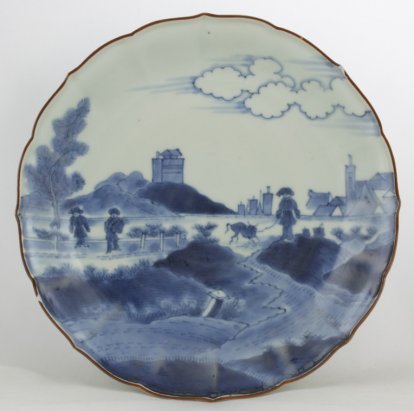
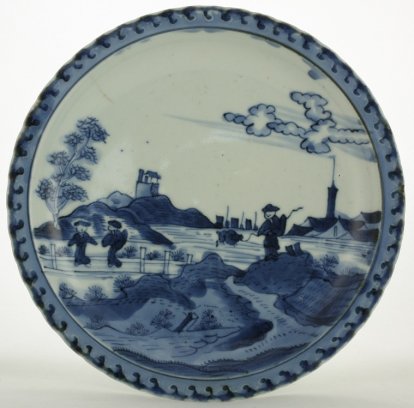
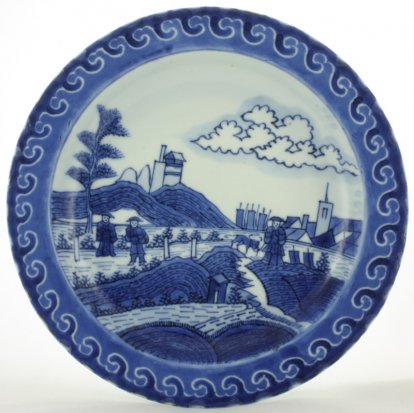
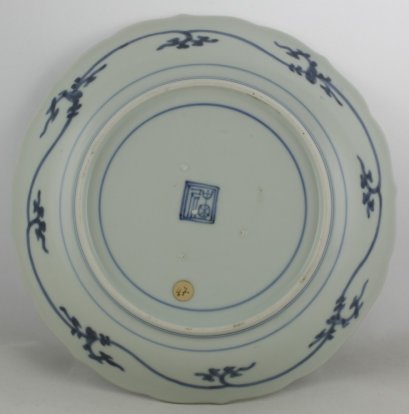
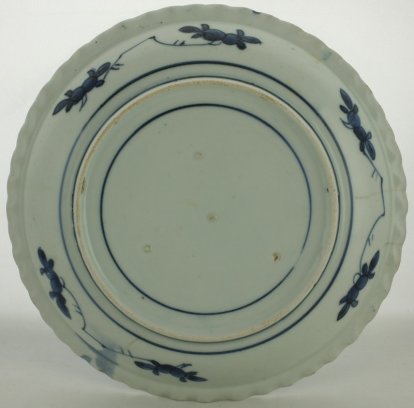
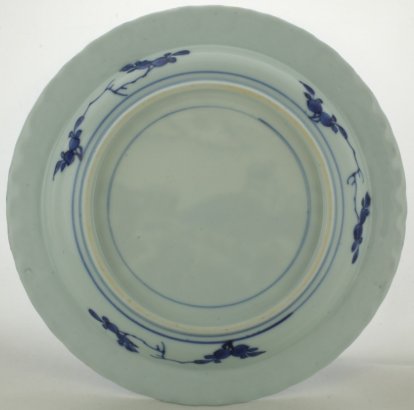

 create websites
create websites